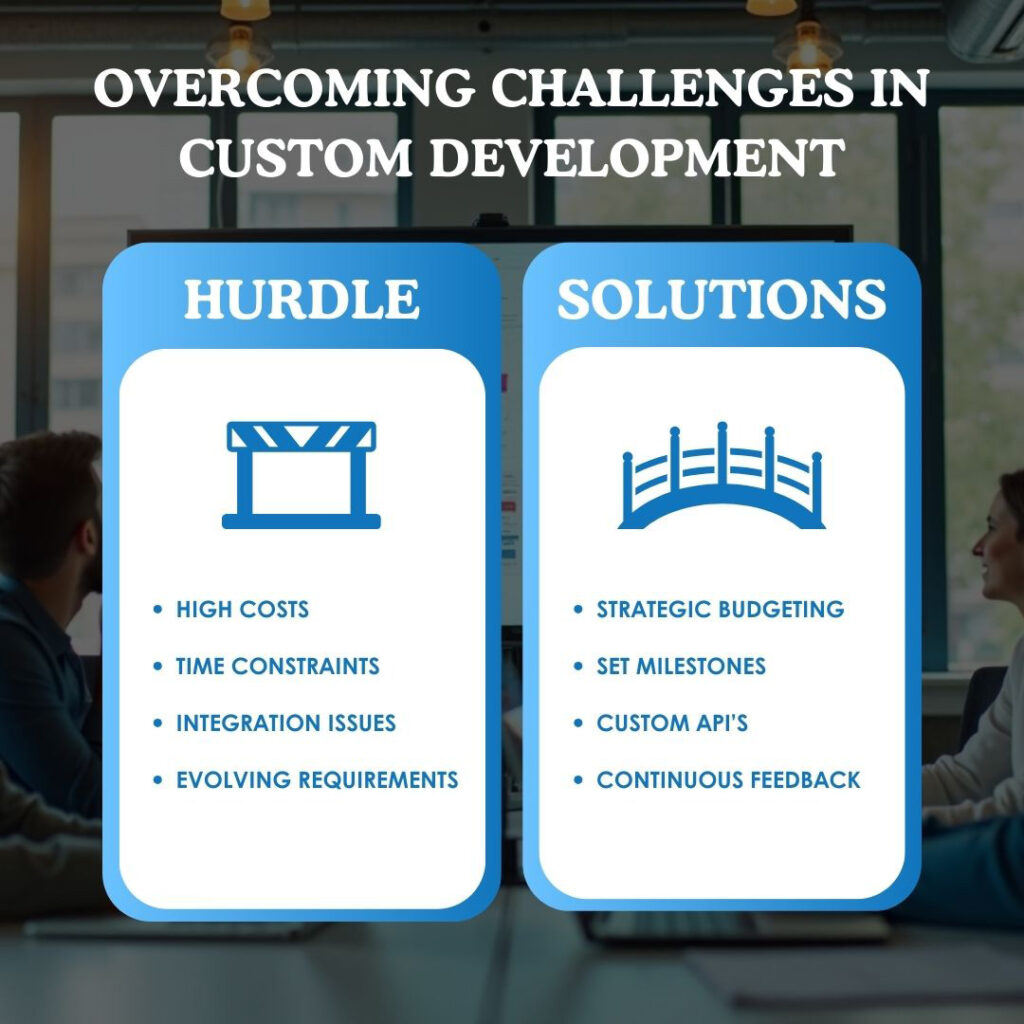





In 2025, the digital landscape demands agility and precision. Off-the-shelf software, while convenient, often creates more problems than it solves. It forces your business to adapt to its limitations, rather than the other way around. This mismatch leads to frustrating workflow bottlenecks that stifle growth and drain resources. To truly thrive, you must recognize and address these challenges head-on.

Imagine your sales team using one system, your marketing team another, and your customer service team yet another. This creates data silos – isolated pockets of information that don’t communicate with each other. You need to integrate existing software to break down these barriers. Data should flow seamlessly, providing a unified view of your operations. When your systems “talk” to each other, you gain valuable insights, improve collaboration, and make informed decisions faster.
Are manual processes slowing you down? Are outdated systems hindering your team’s productivity? It’s time to modernize business processes by automating legacy systems. In 2025, automation is not a luxury; it’s a necessity. Eliminate repetitive tasks, reduce human error, and free up your team to focus on strategic initiatives. By embracing modern technologies, you can streamline operations and drive efficiency.
Your business is growing, but is your software keeping pace? Many businesses find that their software cannot handle increased data volumes or new user demands. You must scale software applications to overcome these growth challenges. Build systems that are flexible and adaptable, allowing you to seamlessly expand your operations. This ensures that your software remains a valuable asset, not a liability, as your business evolves.

In today’s data-driven world, real-time insights are crucial for making timely decisions. But how can you access these insights if your data is scattered or insecure? You need to secure data to gain real-time operational insights. Implement robust security measures, centralize your data, and leverage analytics tools to extract meaningful information. This allows you to monitor performance, identify trends, and make data-driven decisions that drive business success.
Frustrated employees and unhappy customers are clear signs of poor user experience. Generic software often leads to clunky interfaces and confusing workflows. You must enhance user experience to eliminate this friction. Create intuitive and user-friendly systems that empower your team and delight your customers. By prioritizing user experience, you can increase productivity, improve satisfaction, and build a loyal customer base.
By identifying and addressing these workflow bottlenecks, you can unlock the full potential of your business.
You’ve identified the bottlenecks. Now, how do you break free? The answer lies in software customization. It’s about building solutions that fit your business like a glove, rather than forcing your business to fit into a pre-made mold. Customization empowers you to create systems that align with your unique processes, goals, and user needs.
Your business has specific needs that generic software can’t address. To truly meet business requirements, you need automation tailored to your workflows. Custom software allows you to automate repetitive tasks, streamline data entry, and integrate disparate systems. Imagine automatically generating reports, syncing customer data across platforms, or automating approval processes. This level of precision not only saves time but also significantly reduces the risk of human error.
Data is the lifeblood of modern businesses. But if your data is scattered or difficult to access, it’s virtually useless. Implement custom software solutions to centralize your data and gain actionable insights. Build dashboards that provide real-time visualizations of key metrics. Integrate data from various sources into a single, unified platform. With custom data management tools, you can make informed decisions faster and more effectively.
When your employees and customers struggle with clunky interfaces or confusing workflows, productivity plummets. Optimize user experience by creating intuitive and user-friendly systems. Build interfaces that are tailored to specific user roles. Implement features that simplify complex tasks. By focusing on user experience, you can increase employee satisfaction, improve customer engagement, and drive overall efficiency.
Your business is dynamic, and your software should be too. Build scalable applications that can adapt to your evolving needs. Custom software allows you to add or remove features as required, integrate new technologies, and expand your user base without disrupting operations. This flexibility ensures that your software remains a valuable asset as your business grows.
In today’s competitive landscape, differentiation is key. Develop customized solutions that set you apart from the competition. Build features that are unique to your business. Create workflows that provide a seamless customer experience. By leveraging software customization, you can gain a competitive edge and establish yourself as an industry leader.
While the initial investment in software customization may be higher than off-the-shelf solutions, the long-term cost savings are significant. Achieve cost savings by reducing manual labor, minimizing errors, and improving overall efficiency. Custom software allows you to eliminate redundant systems, streamline processes, and optimize resource allocation. This translates into a higher return on investment and a more sustainable business model.
By embracing software customization, you’re not just fixing problems; you’re building a foundation for future success.
Theory is powerful, but seeing real-world applications brings the true value of software customization to life. Let’s explore a few scenarios where specialized development transformed businesses, demonstrating how tailored solutions can address unique challenges and drive significant results.
Imagine an e-commerce company experiencing rapid growth. Their off-the-shelf platform struggles to handle the increased order volume, leading to inventory discrepancies and delayed shipments. By choosing to implement custom software development, they create a system that integrates real-time inventory tracking with automated order fulfillment. The software optimizes warehouse management, predicts demand, and streamlines shipping logistics. This results in faster delivery times, reduced errors, and improved customer satisfaction, ultimately boosting their bottom line.
Consider a healthcare provider aiming to improve patient care and streamline administrative tasks. Their existing electronic health record (EHR) system doesn’t integrate with their patient scheduling software, leading to scheduling conflicts and data entry errors. By choosing to meet specific needs through customized integration, they create a unified system that automates appointment reminders, securely shares patient data between departments, and provides real-time access to medical records. This leads to better patient outcomes, reduced administrative overhead, and enhanced staff efficiency.
A manufacturing company seeks to optimize its production processes and reduce downtime. Their current system lacks real-time visibility into inventory levels, production schedules, and equipment performance. By choosing to leverage specialized development, they create a custom dashboard that provides real-time insights into key metrics. The system tracks production progress, predicts maintenance needs, and alerts managers to potential bottlenecks. This results in increased productivity, reduced waste, and improved overall operational efficiency.
A rapidly scaling technology startup finds their off-the-shelf CRM system is no longer sufficient to manage their growing customer base and complex sales processes. By choosing to create a custom CRM, they develop a system that seamlessly integrates with their existing project management software, automates lead nurturing, and provides detailed analytics on sales performance. This tailored solution allows them to streamline their sales pipeline, improve customer relationship management, and scale their operations effectively.
These scenarios illustrate how software customization can address specific challenges across various industries. By choosing tailored solutions, businesses can overcome limitations, optimize workflows, and achieve significant growth.
Custom software isn’t just about building standalone solutions. It’s also about enhancing and extending the functionality of your existing applications. Integrating custom software and apps creates a cohesive ecosystem that streamlines workflows and empowers your team to work more efficiently.
Imagine your core business software lacks a critical feature that would significantly improve your team’s productivity. Instead of replacing the entire system, you can create integrated software applications to add that missing functionality. Custom-built modules, plugins, or add-ons can seamlessly integrate with your existing software, providing the specific tools and features your team needs. This approach allows you to leverage your existing investments while enhancing the overall functionality of your applications.
Mobile access to critical data and workflows is essential in today’s fast-paced business environment. Utilize custom software development to create mobile apps that seamlessly integrate with your existing software systems. This allows your team to access important information, complete tasks, and collaborate from anywhere, at any time. Imagine your sales team accessing real-time customer data on their smartphones, or your field technicians submitting work orders through a mobile app. By building seamless user experiences across devices, you can enhance productivity, improve responsiveness, and empower your team to work more effectively.
Integrating custom software and apps creates a unified digital environment that streamlines workflows, enhances productivity, and empowers your team.
Embarking on a software customization project requires expertise, collaboration, and a clear understanding of your business needs. Partnering with a reputable software development company ensures a smooth and successful journey, transforming your vision into a powerful, tailored solution.
The foundation of any successful software customization project is a clear understanding of your business requirements. A skilled development team will begin by conducting a thorough needs assessment, working closely with your stakeholders to identify pain points, define objectives, and document detailed specifications. This collaborative approach ensures that the final product aligns perfectly with your strategic goals and operational needs.
Software customization is not a one-size-fits-all endeavor. It requires a collaborative design process that involves close communication and feedback loops between your team and the development company. By engaging in a structured software development process, you can ensure that your vision is translated into a user-friendly, efficient, and scalable application. This collaborative approach fosters transparency and ensures that the final product meets your expectations.
Effective project management is crucial for keeping your software customization project on track and within budget. A reputable development company will employ experienced project managers who can oversee all aspects of the project, from planning and development to testing and deployment. Rigorous testing ensures that the software is bug-free and performs as expected. A well-planned deployment minimizes disruption to your operations.
Software customization is an ongoing process, not a one-time event. A reliable software development company will provide ongoing support and maintenance to ensure that your application remains secure, up-to-date, and aligned with your evolving business needs. This includes bug fixes, security patches, performance optimizations, and feature enhancements. By choosing a partner that prioritizes long-term support, you can ensure the longevity and success of your custom software solution.
By partnering with the right development company, you can confidently navigate the complexities of software customization and create a powerful tool that drives your business forward.
Software customization, when approached strategically, can be a highly efficient and cost-effective investment. By carefully planning and managing the development process, you can ensure that your project stays within budget and delivers a strong return on investment.
One key factor in controlling development time and cost is to clearly define your business requirements upfront. A well-defined scope minimizes scope creep and ensures that the development team focuses on building the features that are most critical to your business. Additionally, using agile methodologies and iterative development allows for flexibility and adaptability, ensuring that your project stays on track and within budget.
Another important aspect is to partner with a software development company that has a proven track record of delivering projects on time and within budget. Look for a company that prioritizes transparency, communication, and collaboration. A reliable partner will provide regular updates, manage risks proactively, and ensure that your project is delivered to your satisfaction.
By controlling development time and cost, you can ensure that your software customization project is a success. Custom software can be a powerful tool for achieving your business goals, streamlining operations, and gaining a competitive advantage.
Ready to eliminate workflow bottlenecks and unlock the full potential of your business? Don’t let outdated software hold you back. Schedule a consultation with our experts today to discuss your specific needs and discover how custom software solutions can transform your operations. Let’s build a system that aligns perfectly with your business goals, streamlines your processes, and empowers your team to achieve more. Contact us now and take the first step towards a more efficient and successful future.
"*" indicates required fields
